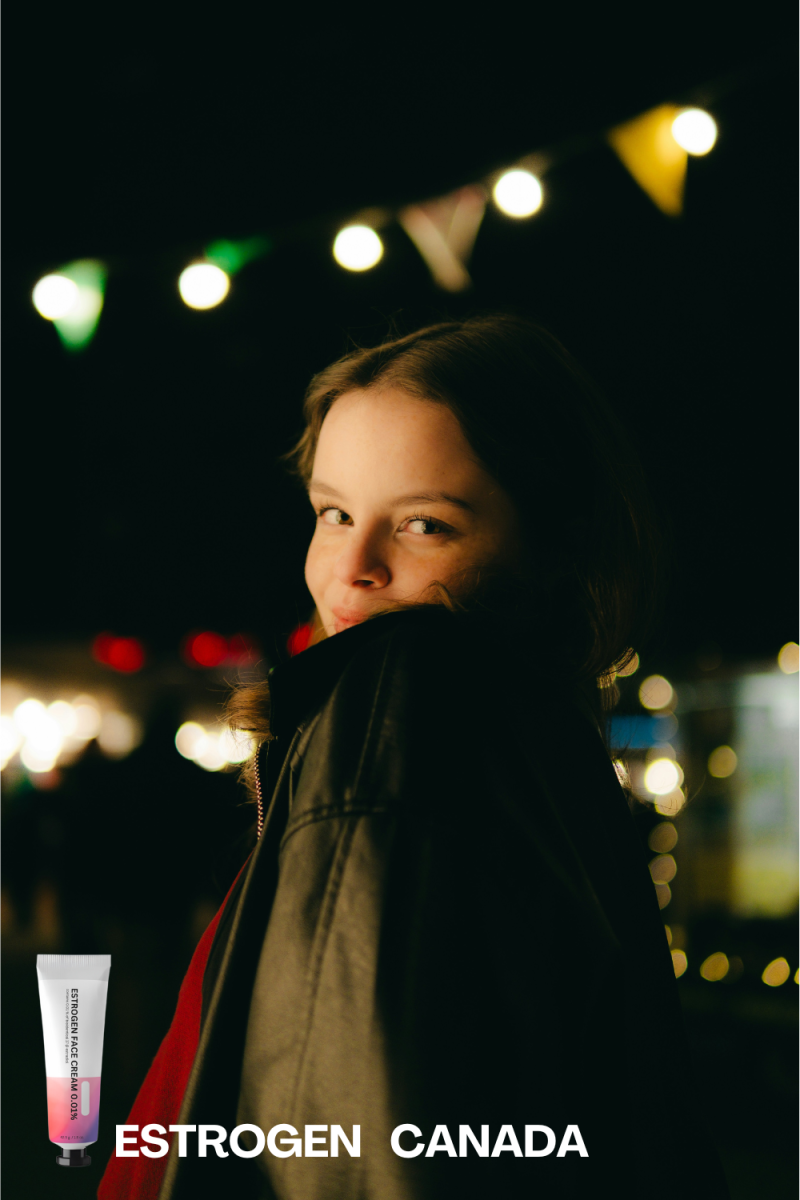Aging Skin and the Estrogen Connection
If you’re in your 30s, 40s, or beyond, you’ve probably noticed changes in your skin. Fine lines appear seemingly overnight. Your once-plump cheeks may feel a little less firm. And despite all the moisturizers in the world, your skin still feels drier than it used to. What’s going on?
For many women, the culprit isn’t just age, t’s declining estrogen. But what if you could replenish what your skin is missing, right where it needs it, without affecting the rest of your body? That’s where topical estradiol comes in.
Unlike traditional hormone replacement therapy (HRT), which affects the entire body, topical estradiol is applied directly to the skin, targeting the signs of aging without influencing overall hormone levels. It’s not HRT, it’s skin care at the hormonal level.
Every woman at some point in her life faces the perplexing dilemma of gracefully aging skin. When I began experiencing the initial signs of menopause, I was inundated with warnings about estrogen being the villain of the story. Like many, the perception that estrogen is a ‘dangerous poison’ heavily influenced my thoughts. Yet, the more I delved into the science of skincare and hormones, the clearer it became that the truth is nuanced. It’s not about villainizing estrogen, but rather about understanding its role and tapping into its benefits responsibly. This revelation led me to discover the world of estradiol face creams, not systemic hormone replacement, but a targeted, non-HRT approach designed to rejuvenate and revitalize.
*This blog post is for informational purposes only and is not intended as medical advice. Always consult with a healthcare professional before starting any new skincare or treatment regimen.
Embracing a New Perspective: Benefits of Topical Estradiol
Rejuvenation and Hydration: The Core Benefits
Estradiol cream works by engaging the estrogen receptors located in your skin cells. This targeted activation leads to improved collagen synthesis, a vital protein for maintaining skin structure and reducing the appearance of fine lines. Additionally, estradiol boosts skin hydration, fighting dryness by optimizing the skin’s natural moisture barrier.
Elasticity and Firmness: Essential Aspects of Youthful Skin
As we age, maintaining skin elasticity becomes more challenging due to declining estrogen levels. Estradiol cream helps combat this by supporting the production of elastin, giving skin its bounce back. This not only enhances skin firmness but also contributes to a more youthful and lifted appearance.
The Importance of an Informed Choice
Navigating the world of skincare and hormones requires thoughtful consideration. Treatment decisions should reflect individual needs and circumstances, acknowledging the value of professional healthcare advice. Through informed discussions, women can harness the potential of estradiol cream, tailoring it to fit within a comprehensive skincare regimen that aligns with personal health goals.
Why Estradiol is the Most Natural Form of Estrogen
Many people think of estrogen as a single hormone, but there are actually three main types:
- Estrone (E1): The weakest form, dominant after menopause.
- Estradiol (E2): The most potent and biologically active form, responsible for most of estrogen’s effects in the body.
- Estriol (E3): A weaker estrogen, often used in some bioidentical HRT formulations.
Estradiol is the form our bodies naturally produce in abundance before menopause. Using estradiol topically means you’re replenishing the exact estrogen your skin is missing, not a synthetic alternative, not a weaker derivative, but the real thing.
Topical Estradiol: A Natural, Non-HRT Solution for Aging Skin
What Makes Topical Estradiol Different?
Many women hesitate to use traditional HRT due to concerns about its systemic effects. Topical estradiol, however, is a different approach:
- It’s non-systemic. Unlike oral or transdermal HRT, topical estradiol doesn’t significantly enter the bloodstream. It works where you apply it—on your skin.
- It’s bioidentical. Estradiol is the exact form of estrogen your body naturally produces, making it the most natural option available.
- It’s designed for targeted results. Rather than affecting your whole body, it helps restore hydration, elasticity, and smoothness to your skin, without altering your overall hormone levels.
What the Science Says
You might be wondering, “If it’s estrogen, doesn’t it get absorbed into the body?” The short answer is not significantly.
Several studies have examined whether topical estradiol raises systemic estrogen levels. The results? Minimal absorption. Research indicates that when applied to the face in low doses, topical estradiol stays largely in the skin, providing localized benefits without meaningfully increasing estrogen levels in the blood.
For example, a study published in Maturitas found that topical estradiol significantly improved skin elasticity and hydration while having negligible systemic effects. Another study in The Journal of Clinical Endocrinology & Metabolism found that estrogen applied to the skin resulted in measurable improvements in skin thickness and collagen content.
That said, while current research is promising, it’s important to acknowledge that most studies have been small. We still need larger-scale studies to confirm these findings. If you have concerns, it’s always best to discuss them with your doctor.
My Experience: The Moment I Realized My Skin Needed Estradiol
Like most women, I spent years believing estrogen was something to be feared. We’ve all heard the warnings, estrogen is dangerous, it causes problems, it’s something to avoid. But as I approached menopause, I started to wonder: What if that’s not the whole story?
I did everything “right” for my skin. I used hyaluronic acid, retinol, peptides—all the gold-standard anti-aging ingredients. But something was still missing. My skin was thinning, and no amount of moisturizer could keep it hydrated.
Then I learned that estrogen stimulates hyaluronic acid production from within. It helps skin stay hydrated at a cellular level. It wasn’t that my skincare products weren’t working, it was that my skin no longer had the hormonal support it needed.
That’s when I tried topical estradiol. I started slowly, and within weeks, my skin felt different, more resilient, less prone to dryness. Over time, the fine lines softened, and my skin regained some of the elasticity I thought was gone forever.
Now, I’m angry that this knowledge wasn’t more widely available. Why aren’t we told about this? Why is something so effective kept under wraps?
What You Need to Know Before Using Topical Estradiol
While topical estradiol is a promising option, here are some things to keep in mind:
- Consult your doctor if you have concerns. Even though studies show minimal systemic absorption, it’s always best to discuss any hormone-related product with a healthcare professional.
- Be patient. Results take time. Unlike Botox or fillers, topical estradiol works by restoring skin health over weeks and months.
- Apply it at night. To prevent potential sun sensitivity, nighttime application is recommended.
- Wash your hands after application. This prevents accidental transfer to unintended areas.
Final Thoughts
Aging skin isn’t just about wrinkles, it’s about what’s happening beneath the surface. Declining estrogen levels play a major role, and while traditional skincare products can help, they don’t address the root cause.
Ultimately, understanding the role of estradiol in skincare redefines the narrative of aging. Estradiol face creams represent a thoughtful integration of science with holistic practices, embodying a shift towards balance and personalization in skincare routines. For women experiencing the intricacies of aging, these creams offer an opportunity to connect deeply with your skin’s evolving needs without the apprehension surrounding systemic HRT.
Topical estradiol offers a science-backed, non-systemic, and natural way to restore what your skin is missing, without the risks of full-scale HRT. If you’re starting to see the signs of estrogen-deficient skin, it may be time to consider a targeted solution that works with your body, not against it.
Emily Carter’s Story: From Confusion to Clarity on Systemic vs. Non-Systemic
“I was completely overwhelmed by all the information out there on hormone treatments and skincare. Every time I thought about using an estrogen product, I worried about systemic effects. What if it altered my hormone levels too much? This fear kept me away from potentially helpful treatments for a long time.
Finally, I decided to educate myself, and learning the difference between systemic and non-systemic treatments was a game-changer. I discovered that non-systemic estradiol creams focus on the skin’s surface and don’t mess with your overall hormone levels. This understanding opened me up to trying topical estradiol, which targets my specific skincare concerns by providing key hydration and elasticity benefits.
The results have been remarkable. My skin feels firmer and looks more youthful, and I have a new-found confidence knowing that I’m addressing my skin’s needs without affecting my body’s natural balance. I only wish I had understood this difference sooner!”
– Emily Carter, 47, Victoria, British Columbia, Canada
📌 External Links (High-Authority References):
1️⃣ “Topical Estrogen Therapy and Skin Health: An Overview”
This article from a high-authority dermatology journal discusses how topical estrogen treatments work to improve skin health without significant systemic effects, making them a safer alternative for many.
🔗 https://www.ncbi.nlm.nih.gov/pmc/articles/PMC3764392/
2️⃣ “Estradiol Receptors in the Skin: Science Behind Topical Applications”
This research explores how estradiol interacts specifically with skin receptors, explaining why it can effectively target skin health without influencing body-wide hormone levels.
🔗 https://www.sciencedirect.com/science/article/pii/S0022202X15336412
3️⃣ “Non-Systemic Hormone Therapies: Safety and Efficacy for Long-Term Use in Skincare”
An article examining the safety profiles of non-systemic hormone treatments, offering insights into their targeted efficacy for conditions like skin aging.
🔗 https://www.mayoclinicproceedings.org/article/S0025-6196(11)64520-X/fulltext
[Note: Always consult with a healthcare professional before beginning any new treatment regimen. Individual considerations vary, and personalization is key.]



